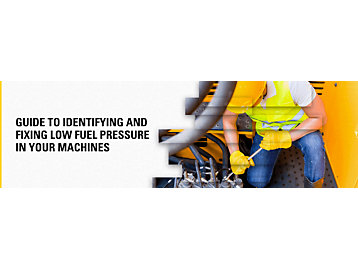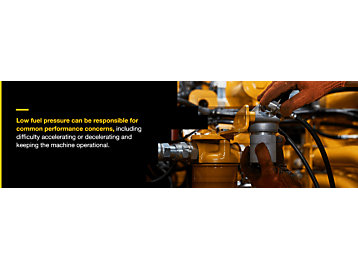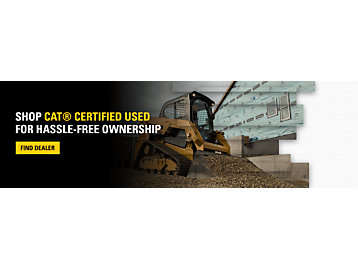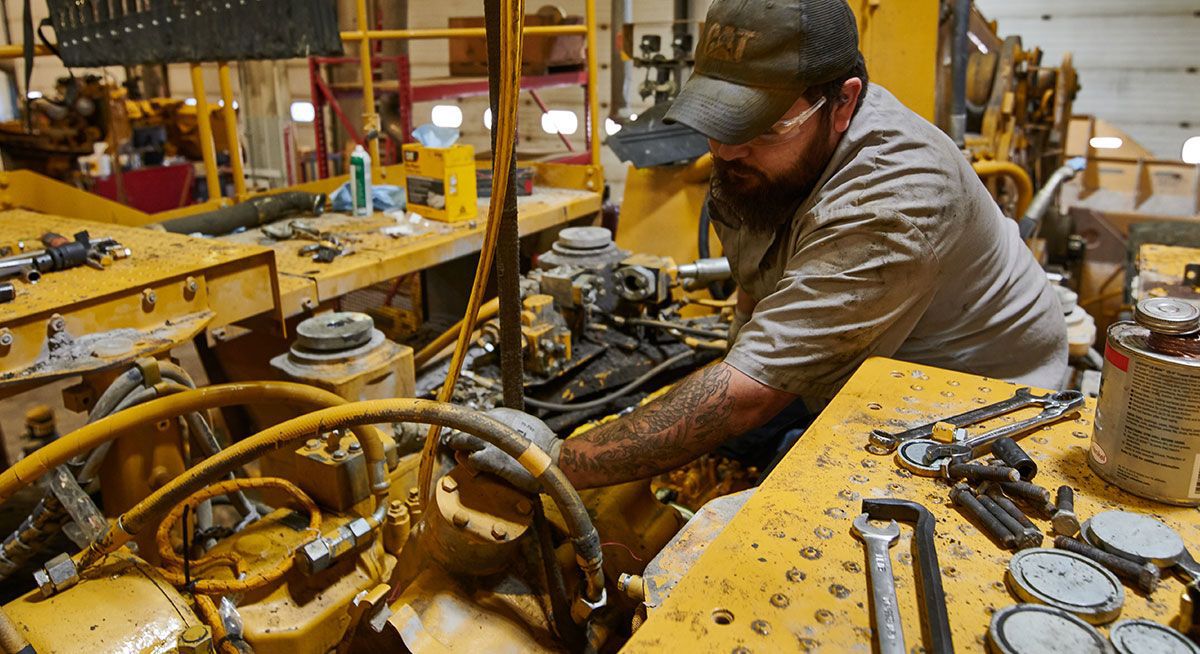If you already have an existing account with another Cat App, you can use the same account to sign in here.
One Account. All of Cat.
Your Caterpillar account is the single account you use to log in to select services and applications we offer. Shop for parts and machines online, manage your fleet, go mobile, and more.
Account Information
Site Settings
Security
Author: Small Business Expert | August 17, 2020 | Topic: Used Equipment

Low fuel pressure can cause a myriad of problems for your machine, all of which can cut into valuable work time. Several factors can affect construction equipment fuel pressure, and understanding how to identify and fix these issues will help prevent future fuel pressure problems.
What Causes Low Fuel Pressure in Heavy Equipment?
In many cases, low fuel pressure is a simple fix once you have identified the cause. Three of the most common causes of heavy equipment low fuel pressure are a faulty regulator, a fuel pump malfunction or problems with the fuel lines.
A Faulty Regulator
The regulator is responsible for regulating and adjusting the pressure level of the fuel in your machine's system. When operating correctly, the regulator ensures pressure never gets too high or too low — which is why it's one of the first places you should check if you find a problem with your fuel pressure. A few symptoms of a failed regulator include:
- Black smoke coming out of the exhaust.
- The engine not starting, or it misfiring when it does.
- Sluggish operation and problems accelerating and decelerating.
- Running out of fuel a lot sooner than normal.
In addition to low fuel pressure, a damaged regulator can also cause excessively high pressure levels inside your machine, which is a hazard. Therefore, it is vital that you repair or replace the regulating element immediately.
A Fuel Pump Malfunction
The fuel pump moves fuel to your machine's engine. If it isn't operating at full-force, your machine won't receive enough fuel pressure to function correctly because it isn't receiving enough fuel. Some common fuel pump malfunctions include:
- A clogged screen filter: A fuel pump has two separate filters: the fuel filter and the screen filter. The screen filter is at the bottom of the pump and keeps large debris from entering the fuel system. When it becomes clogged, fuel can no longer move through the pump, or it moves too slow for the machine to operate correctly. Symptoms of a clogged screen filter include difficulty starting your machine, backfiring or difficulty accelerating. Luckily, this is an easy fix — you can either remove, clean and replace the screen filter or invest in a new one if the old one has been damaged by the debris.
- Low voltage: To move the fuel through the machine, the fuel pump requires a specific level of voltage from the battery. If the voltage is too low, the fuel pump will not have enough power to supply the engine. Low voltage is usually a result of either a weak or dead battery, or an issue with the wiring.
- Defective fuel pump relay: The fuel pump relay is controlled by the ignition and controls the power current that gets sent to the fuel pump. When it's defective, the fuel pump is unable to operate correctly, and, as a result, the engine might stall or refuse to start at all. A trained mechanic can replace a defective fuel pump.
Problems With the Fuel Lines
The fuel line is a thin hose that carries fuel from your machine's gas tank to the rest of the system. If there is a problem with the fuel line, the motor can overheat, the engine will stall or you might be unable to start your machine at all. A few common problems that can arise with the fuel line are:
- Clogged fuel lines: A clogged fuel line means little to no fuel is reaching your engine. The result is a machine that either won't start, or one that sputters and sporadically shuts down after it's turned on.
- Leaking fuel lines: Leaking fuel lines are not only a safety hazard but also a money waster. When your fuel line is leaking, excess diesel fuel drips onto the ground below your machine. That's why one of the biggest indicators of a fuel leak is having to refill your gas tank more than usual, or after very little use. A strong gasoline or diesel odor is another common indicator.
- Contaminated fuel: Fuel contamination can happen in a variety of ways — for example, a dirty filter can taint incoming diesel fuel, or it may have been bad when you purchased it. Contaminated fuel can cause your engine to sputter or shut down completely. Some of the best indicators of contaminated fuel are excess smoke, a foul smell or fuel discoloration. If contaminated fuel is the problem, make sure you note where you purchased the fuel and dispose of any remaining in the tank.
- Not enough fuel: Finally, one simple — yet surprisingly common — problem with the fuel line is that you simply don't have enough fuel in your machine. Running a machine without enough fuel can cause the engine to overwork, the motor to overheat and the fuel pressure to run low.
How to Identify Low Fuel Pressure
Low fuel pressure can manifest itself in many different ways. Common symptoms include:
- Engine trouble: If you have difficulty starting your machine or experience frequent stalls, misfires and backfires, low fuel pressure could be to blame.
- Performance issues: Low fuel pressure can be responsible for common performance concerns, including difficulty accelerating or decelerating and keeping the machine operational.
- Unusual occurrences: Excess smoke from the exhaust, strong smells in the fuel tank and leaking substances can all indicate a problem with fuel pressure.
- Lower fuel efficiency: Finally, if you have had to refill your gas tank frequently — to little or no avail — there is likely a more significant problem with fuel pressure at play.
If you suspect low fuel pressure is to blame for your machine's poor performance, use a fuel pressure tester to analyze the pressure fluctuation in your machine and determine whether the pressure is normal, low or nonexistent.

How to Fix Low Fuel Pressure
Once you have identified a decrease in fuel pressure, the next step is to correct the issue and prevent future problems from occuring. Whether you plan to tackle repairs on your own or take your machine to a qualified mechanic, it's a good idea to check each of these critical areas of your machine so you can create an effective action plan:
- The gas tank: Start with your gas tank. Is it at least a quarter of the way full with quality, in-date fuel? Are there any visible signs of a leak, such as wet or sticky spots in the tank holding area?
- The fuel lines: If everything looks okay with your gas tank, it's time to check the nearby fuel line. Make sure it is connected and not broken, out of place or leaking fuel.
- The battery: If your fuel tank and lines are intact, the problem may be with your battery. Make sure all connections are hooked up between your battery and the rest of the machine system and test the life of your battery with a power probe or multimeter.
- The fuel pump: Next, locate and inspect your fuel pump, including the filter screen and relay element. If one or both of these parts is damaged, make the necessary replacements and try operating your machine as normal.
- The pressure regulator: Finally, if you identified no issues with the above elements, the problem is likely with the pressure regulator. Use a fuel pressure gauge to test your regulator. If you're not sure how to connect the pressure gauge, consult your owner's manual or local dealership. If the fuel pressure regulator is the problem, you will need to have it repaired or replaced by a professional.
If you have tried all of these steps to solve your fuel pressure problem, it's time to schedule an appointment with a qualified mechanic or equipment specialist so they can identify any more significant issues that may be at play.
Benefits of Fixing Low Fuel Pressure
If you have low fuel pressure, it's essential that you correct the problem sooner, rather than later. For you, fixing your machine's fuel pressure problem means:
- Efficient operation: Low fuel pressure can cause engine failure, difficulty accelerating and sluggish navigation. When you correct the problem, your machine becomes as efficient and easy-to-use as the day you first bought it. Stable pressure means you spend less time with a stalled machine and more time operating it.
- More resale value: If you plan to trade-in or resell your machine, it must first be in good working condition. Most dealerships and private owners are hesitant to accept a machine with visible issues — even if they are a simple fix — because there might be even more issues present that aren't as visible. Before advertising your machine for resale, make sure everything is operating as it should, and replace any faulty parts.
- Lower cost of operation: One of the biggest benefits of fixing low fuel pressure is how much you can reduce heavy equipment fuel costs. When equipment pressure is low, the system has to work twice as hard to try and correct the problem, and all that extra energy means you end up spending a lot more money on gasoline or diesel fuel. Additionally, if the pressure problem is a result of a leak, the extra fuel may end up in a puddle on the ground. By identifying and correcting the issue as soon as possible, you minimize the risk of wasting your money.
- Longevity: When something isn't working correctly inside your fuel pump, lines or engine, it puts pressure on other parts of your machine to operate more frequently or at a higher level than usual. Therefore, what begins as a simple problem with low fuel pressure can cause other parts to break down faster, resulting in a more costly fix in the future.
As you can see, fixing your fuel pressure problem is imperative to the efficiency and cost of operating your machine, as well as its overall value and longevity. However, fixing the problem is not enough — you should also take steps to prevent future pressure issues.
How to Stop Low Fuel Pressure and Prevent Future Issues
If you've gone through the work of locating, identifying and fixing the problem with your machine, the last thing you want is to run into a similar problem down the road. Here are some tips to reduce heavy equipment fuel pressure problems in the future:
- Change all filters regularly, including the filter screen and fuel filter.
- Use high-quality, in-date fuel from a trusted supplier.
- Rather than operate your machine at half-efficiency, perform diagnostic tests and replace all necessary parts as needed.
- Schedule maintenance check-ups throughout the year, so a mechanic can identify and correct possible concerns before they grow into larger ones.
By following these tips, you are doing your part to make sure your equipment and machinery operate efficiently for years to come.
How Can I Make My Engine More Fuel Efficient?
If you are interested in reducing fuel consumption, there are certain steps you can take to make sure your engine is as efficient as possible.
Follow these tips if you are concerned about your construction equipment's fuel efficiency:
- Follow manufacturer instructions: Follow all manufacturer or dealership guidelines for your machine, including the brand and type of fuel, oil, filters and replacement parts. These specifications are suggested because they have been tested and confirmed as the most efficient for your machine.
- Keep it fine-tuned: Keep your heavy equipment healthy by performing regular self-inspections. Make sure the correct tires are installed and that they are always filled to the correct pressure. Inspect and change all filters regularly. Keep your machine clean to avoid build-up in sensitive areas.
- Know when to consult a professional: It's always a good idea to learn your way around your machinery so you can identify and correct small issues as they arise. This can save you a lot of money and time in the future. However, it's essential that you understand when it's time to consult a professional. Some problems are too big to figure out, and trying to tackle them on your own could lead to further damage.

How to Save Diesel Consumption
If you're trying to cut fuel consumption — whether for the sake of your wallet or the environment — here are some tips to follow:
- Avoid idling: Turn off your machine when you are not using it, rather than leaving it to idle and burn through valuable diesel. A machine that idles for 30 seconds or longer can consume more fuel than stopping and restarting the machine.
- Operate smoothly: Whenever possible, operate the machine slowly and without needless acceleration. Frequent accelerating and decelerating require more fuel than smooth, steady movements.
- Seal your gas cap: Make sure you have a gas cap and that it is adequately sealed. Otherwise, diesel could spill or seep out during the day.
- Do your research: Research and compare the cost of diesel fuel at all nearby shops daily, rather than using the same gas station each time.
- Lighten your load: Never operate your machine with unnecessary attachments or accessories attached — such as a backhoe loader or dozer piece — as the additional weight will make you use up your fuel faster. If the job or project doesn't require it, it's best to leave it behind.
Shop Cat® Certified Used for Hassle-Free Ownership
Low fuel pressure can cause a lot of problems, but by following these tips, you will be able to identify the root of the issue and take the steps necessary to correct it. One of the best things you can do to ensure a fully operational machine is to make sure you purchase it from a reputable dealership.
When you're shopping for used machines, you need to work with a company you can trust. Cat® dealers source most used equipment from rental leases, trade-ins and lease returns and are standing by to help you navigate the process. Your Cat dealer will help you choose the best machine for your job, budget and specific requirements. Find a Cat dealer near you to get started.







